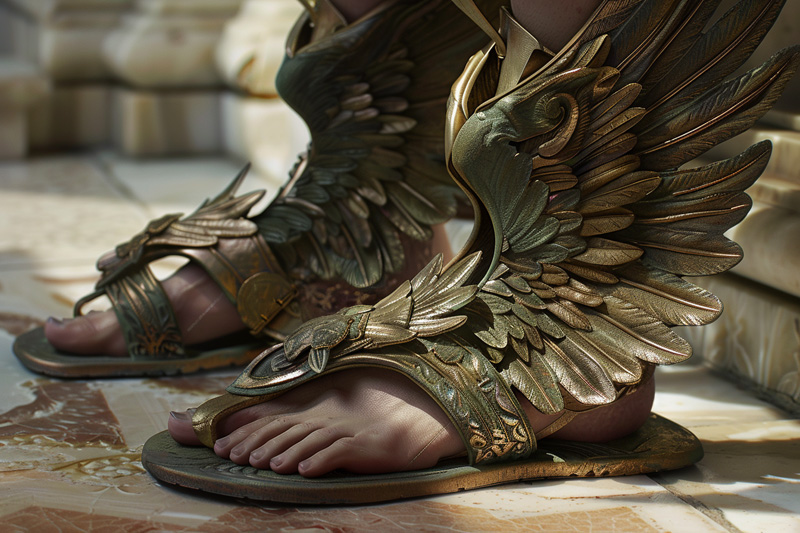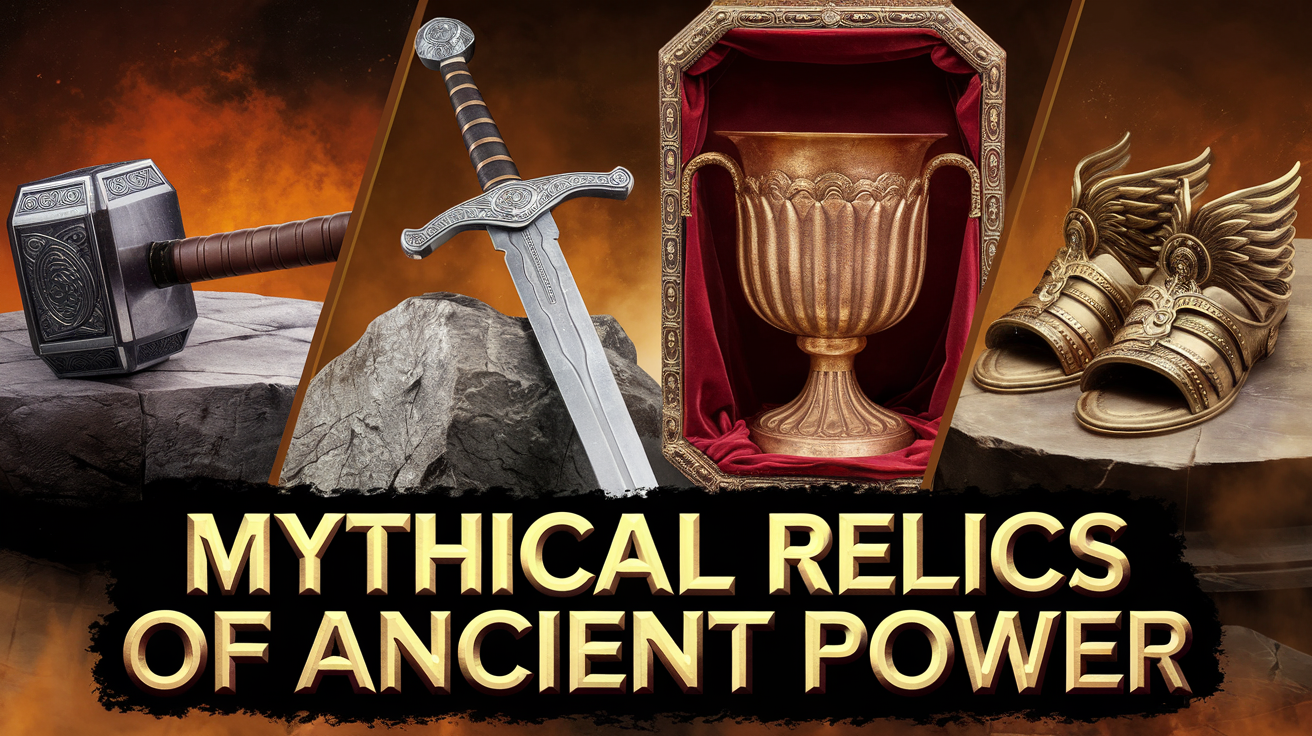Ancient tales have a unique way of whisking us to realms rich with mystery and magic. Handed down through centuries, these stories shape our understanding of the world, offering us everything from wisdom to cautionary tales. But some objects from these myths go beyond symbolism—they embody unimaginable power, wielding influence, granting wishes, or even bringing instant demise. Here’s a look at 41 of the most extraordinary mythological objects and weapons ever, relics that continue to captivate our imagination.
41. The Staff of the Monkey King

The Staff of the Monkey King from Chinese mythology is a true powerhouse. Wielded by Sun Wukong, this mystical staff changes size and shape, from needle-small to towering in height. Its strength isn’t just physical—it symbolizes adaptability and resilience, perfectly capturing Sun Wukong’s clever and resourceful nature.
40. The Hand of Glory

Steeped in European folklore, the Hand of Glory is a grisly yet powerful item. Made from a hanged man’s hand, this eerie candleholder is said to unlock doors and immobilize anyone who sees its light. Though a tool for thieves, it’s a dark reminder of the supernatural forces that lie beyond our control.
39. The Helm of Darkness

In Greek mythology, Hades’ Helm of Darkness grants invisibility, allowing the god of the underworld to move undetected. Beyond mere stealth, the helmet embodies themes of fear and the unknown, adding layers to the mythology of death and what lies beyond.
38. The Cornucopia

This iconic symbol of abundance, also called the Horn of Plenty, comes from Greek mythology. Overflowing with fruits and flowers, the Cornucopia is a symbol of prosperity and a reminder of nature’s bounty, often associated with Demeter, the goddess of the harvest.
37. The Tarnhelm

From Norse mythology, the Tarnhelm, owned by the dwarf Alberich, allows its wearer to become invisible and shapeshift. The helmet taps into themes of deception and transformation, echoing the myths’ fascination with the blurred lines between reality and illusion.
36. Mjölnir

Thor’s mighty hammer, Mjölnir, isn’t just a weapon—it’s a symbol of protection. With its legendary power to level mountains, Mjölnir represents the strength and resilience of the Norse gods, embodying both destruction and the power to bless.
35. Kusanagi-no-Tsurugi

A revered sword in Japanese mythology, Kusanagi-no-Tsurugi was discovered in the tail of a serpent slain by the god Susanoo. Symbolizing strength and authority, it has become a representation of Japan’s imperial lineage.
34. Pandora’s Box

In Greek mythology, Pandora’s Box is a cautionary tale against curiosity. When Pandora opened the box, all the world’s evils were released—except hope. This enduring story serves as a reminder of temptation’s consequences and the resilience of hope.
33. The Club of Dagda

Irish mythology introduces us to Dagda’s club, which can kill nine enemies at once or revive the dead. It represents themes of life, death, and rebirth, linking the god to both destruction and nurturing.
32. The Cauldron of Dagda

Also from Irish myth, this cauldron can sustain entire armies, representing abundance and hospitality. It highlights the importance of community and sustenance, underscoring life’s regenerative forces.
31. Seven-League Boots

European folklore gives us the Seven-League Boots, which enable the wearer to take enormous strides. These magical boots capture our yearning for adventure and freedom, symbolizing the endless journey of exploration.
30. The Seal of Solomon

In Jewish and Islamic lore, King Solomon’s ring, known as the Seal of Solomon, controls demons and spirits. Its powers symbolize wisdom and the ethical use of authority, making it a potent symbol of just leadership.
29. Gleipnir

From Norse myth, Gleipnir is a deceptively strong rope binding the wolf Fenrir. It reminds us of hidden strength, capturing the mystery of delicate yet unbreakable bonds that restrain even the most powerful.
28. The Book of Thoth

This tome in Egyptian mythology, said to contain secrets of the gods, symbolizes the pursuit of wisdom. Its knowledge empowers mortals, highlighting the universal importance of wisdom and curiosity.
27. Kaladanda

A Hindu mythological staff, Kaladanda is wielded by Kalki, the final avatar of Vishnu. It signifies the hope of a renewed world, symbolizing the cyclical nature of time and the victory of good over evil.
26. Excalibur

King Arthur’s legendary sword, Excalibur, symbolizes nobility and the ideals of chivalry. With its unbreakable edge, it’s a beacon of justice, embodying the quest for a noble cause.
25. The Golden Apple of Discord

When Eris tossed this apple marked “For the Fairest” among the gods, it led to the Trojan War. The story warns against rivalry and vanity, showing the often-destructive nature of unchecked desire.
24. The Cintamani Stone

In Buddhist and Hindu lore, this mystical gem grants wishes and symbolizes spiritual growth. Its powers emphasize the importance of enlightenment and the pursuit of inner peace.
23. The Peaches of Immortality

In Chinese mythology, these peaches grant eternal life. Grown in the Jade Emperor’s garden, they represent longevity and the rarity of achieving true immortality.
22. Pair Dadeni

A Welsh cauldron that revives the dead, Pair Dadeni symbolizes rebirth. It highlights the themes of life’s cyclical nature and the mystery of regeneration.
21. The Cup of Jamshid

A Persian artefact, the Cup of Jamshid reveals the past, present, and future. It reflects humanity’s pursuit of wisdom and understanding, a timeless aspiration.
20. The Mead of Poetry

This magical Norse drink, created by Odin, grants poetic talent. It represents inspiration, celebrating the transformative power of creativity and storytelling.
19. Baba Yaga’s Mortar & Pestle

In Slavic folklore, Baba Yaga’s massive mortar and pestle allow her to traverse realms. It embodies the mysterious and unpredictable nature of magic and transformation.
18. Aphrodite’s Girdle

A belt that grants irresistible charm, Aphrodite’s Girdle is a symbol of love’s power, embodying beauty’s allure and its sway over the human heart.
17. Freyja’s Falcon Cloak

This Norse cloak lets its wearer become a falcon, symbolizing freedom and the spirit of exploration. Freyja’s cloak captures themes of independence and self-discovery.
16. The Philosopher’s Stone

In Western alchemy, the Philosopher’s Stone turns base metals into gold and grants immortality. It’s a symbol of transformation, representing humanity’s quest for higher knowledge.
15. Aladdin’s Lamp

From “One Thousand and One Nights,” Aladdin’s lamp contains a genie who grants wishes. It’s a powerful symbol of dreams fulfilled, reflecting the universal hope for a brighter future.
14. Winged Sandals

In Greek myth, Hermes’ Winged Sandals allow the wearer to fly, representing agility and freedom. They capture the human desire to transcend earthly limitations.
13. Poseidon’s Trident

Poseidon’s powerful trident controls the seas, symbolizing authority over nature. It underscores humanity’s respect for the ocean and the raw power of natural forces.
12. The Holy Grail

Central to Christian and Arthurian legends, the Holy Grail symbolizes spiritual fulfillment. It reflects the quest for divine connection and the journey toward redemption.
11. Gjallarhorn

In Norse myth, Heimdall’s horn signals impending danger, symbolizing vigilance. It emphasizes the need for readiness and serves as a call to defend what’s sacred.
10. Medusa’s Head

After slaying Medusa, Perseus used her head as a weapon. It represents overcoming fear and the victory of bravery over darkness.
9. The Book of the Dead

An ancient Egyptian text, the Book of the Dead guides souls through the afterlife. It highlights humanity’s desire for eternal peace and protection in the beyond.
8. The Aegis

Zeus’ shield, the Aegis, invokes thunder and lightning. It’s a symbol of protection, representing the strength and authority of the gods.
7. Sampo

In Finnish folklore, Sampo is a magical mill of prosperity. It represents ambition, illustrating humanity’s shared desire for wealth and well-being.
6. Draupnir

Odin’s ring in Norse myth, Draupnir creates nine rings every ninth night. It symbolizes abundance, highlighting the value of generosity.
5. Anansi’s Pot of Wisdom

In African folklore, Anansi’s pot holds all wisdom, symbolizing intelligence and cleverness. It underscores the importance of wit and knowledge in navigating life’s challenges.
4. Shiva’s Trishula

This trident, wielded by the Hindu god Shiva, represents creation, preservation, and destruction, symbolizing the cosmic balance of life.
3. The Scepter of Agamemnon

In Greek legend, Agamemnon’s scepter symbolizes authority and justice. It reminds us of the responsibility that comes with power.
2. The Hammer of Hephaestus

Hephaestus’ hammer embodies creativity and craftsmanship. It’s a symbol of skill, representing the transformative power of art.
1. The Bag of Winds

In Greek myth, Aeolus’ Bag of Winds contains all the winds, symbolizing nature’s unpredictable power. It serves as a reminder of humanity’s need for respect toward natural forces.




























